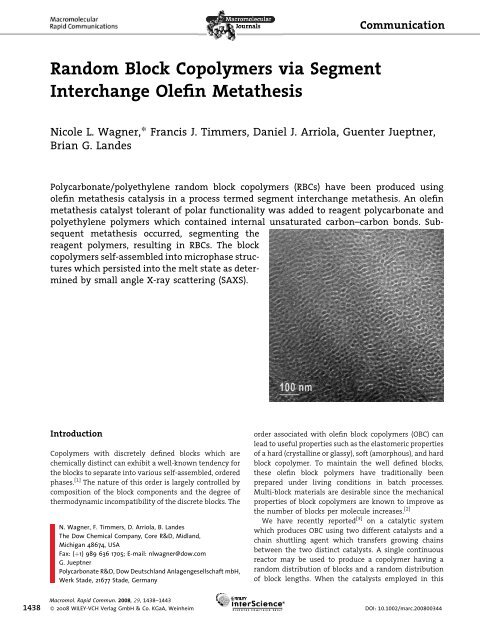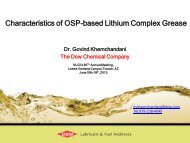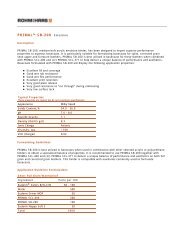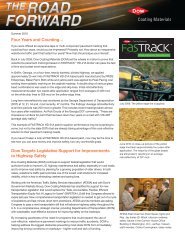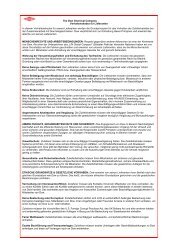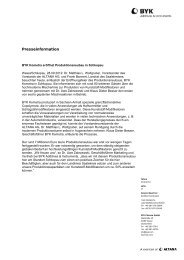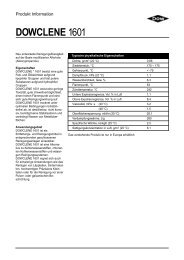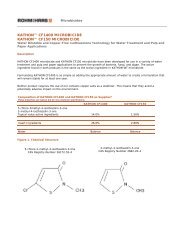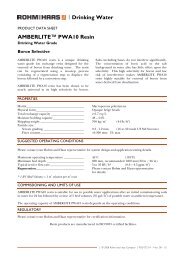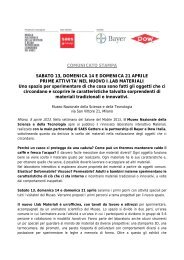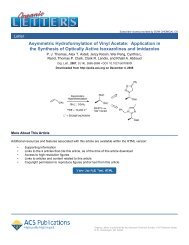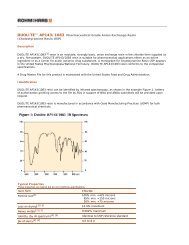Random Block Copolymers via Segment Interchange Olefin ...
Random Block Copolymers via Segment Interchange Olefin ...
Random Block Copolymers via Segment Interchange Olefin ...
Create successful ePaper yourself
Turn your PDF publications into a flip-book with our unique Google optimized e-Paper software.
1438<br />
<strong>Random</strong> <strong>Block</strong> <strong>Copolymers</strong> <strong>via</strong> <strong>Segment</strong><br />
<strong>Interchange</strong> <strong>Olefin</strong> Metathesis<br />
Nicole L. Wagner,* Francis J. Timmers, Daniel J. Arriola, Guenter Jueptner,<br />
Brian G. Landes<br />
Introduction<br />
<strong>Copolymers</strong> with discretely defined blocks which are<br />
chemically distinct can exhibit a well-known tendency for<br />
the blocks to separate into various self-assembled, ordered<br />
phases. [1] The nature of this order is largely controlled by<br />
composition of the block components and the degree of<br />
thermodynamic incompatibility of the discrete blocks. The<br />
N. Wagner, F. Timmers, D. Arriola, B. Landes<br />
The Dow Chemical Company, Core R&D, Midland,<br />
Michigan 48674, USA<br />
Fax: (þ1) 989 636 1705; E-mail: nlwagner@dow.com<br />
G. Jueptner<br />
Polycarbonate R&D, Dow Deutschland Anlagengesellschaft mbH,<br />
Werk Stade, 21677 Stade, Germany<br />
Communication<br />
Polycarbonate/polyethylene random block copolymers (RBCs) have been produced using<br />
olefin metathesis catalysis in a process termed segment interchange metathesis. An olefin<br />
metathesis catalyst tolerant of polar functionality was added to reagent polycarbonate and<br />
polyethylene polymers which contained internal unsaturated carbon–carbon bonds. Subsequent<br />
metathesis occurred, segmenting the<br />
reagent polymers, resulting in RBCs. The block<br />
copolymers self-assembled into microphase structures<br />
which persisted into the melt state as determined<br />
by small angle X-ray scattering (SAXS).<br />
order associated with olefin block copolymers (OBC) can<br />
lead to useful properties such as the elastomeric properties<br />
of a hard (crystalline or glassy), soft (amorphous), and hard<br />
block copolymer. To maintain the well defined blocks,<br />
these olefin block polymers have traditionally been<br />
prepared under living conditions in batch processes.<br />
Multi-block materials are desirable since the mechanical<br />
properties of block copolymers are known to improve as<br />
the number of blocks per molecule increases. [2]<br />
We have recently reported [3] on a catalytic system<br />
which produces OBC using two different catalysts and a<br />
chain shuttling agent which transfers growing chains<br />
between the two distinct catalysts. A single continuous<br />
reactor may be used to produce a copolymer having a<br />
random distribution of blocks and a random distribution<br />
of block lengths. When the catalysts employed in this<br />
Macromol. Rapid Commun. 2008, 29, 1438–1443<br />
ß 2008 WILEY-VCH Verlag GmbH & Co. KGaA, Weinheim DOI: 10.1002/marc.200800344
<strong>Random</strong> <strong>Block</strong> <strong>Copolymers</strong> <strong>via</strong> <strong>Segment</strong> <strong>Interchange</strong> <strong>Olefin</strong> Metathesis<br />
process are electrophilic transition-metal species, the<br />
process is best suited for addition-polymerizable, hydrocarbon-based,<br />
and olefinic monomers. Our interest was in<br />
producing materials with similar block distributions as the<br />
OBC materials made by chain shuttling but containing<br />
blocks with more pronounced differences in compatibility<br />
as compared to OBC.<br />
We now report random block copolymers (RBCs) which<br />
display a similar distribution of blocks and block lengths<br />
as the OBC prepared <strong>via</strong> chain shuttling. a The new RBCs are<br />
prepared <strong>via</strong> olefin metathesis in a process we call<br />
segment interchange. With the advent of olefin metathesis<br />
catalysts tolerant to polar functional groups, [4] the block<br />
composition of these new materials can be extended to<br />
contain polar functionality. Thus, the thermodynamic<br />
incompatibility of the blocks can be substantially<br />
increased such that the appropriately designed materials<br />
spontaneously assemble into ordered structures which<br />
persist at temperatures well into the liquid phase of the<br />
bulk material.<br />
<strong>Segment</strong> interchange is related to the cross-metathesis<br />
(CM) of unsaturated polymers produced by acyclic diene<br />
metathesis (ADMET). ADMET is a metathetical stepgrowth<br />
polymerization reaction which produces polymers<br />
from low molecular weight a, v-terminated diene monomers<br />
resulting in polymer product with a regular<br />
distribution of unsaturated carbon–carbon bonds with<br />
the co-production of ethylene. [5] In the segment interchange<br />
olefin metathesis process however, the substrates<br />
are base polymers which contain low levels of olefinic<br />
unsaturation. Depending on the preparation methods<br />
used, the olefinic unsaturation can be randomly distributed<br />
along the polymer backbone. The polymer units<br />
between the backbone unsaturation are segments and can<br />
be much longer than products arising from CM of polymers<br />
formed <strong>via</strong> ADMET. When the two different types of<br />
polymers, both with backbone olefinic unsaturation are<br />
treated with a compatible olefin metathesis catalyst, the<br />
various segments will interchange and, at equilibrium,<br />
result in a material with a random distribution of<br />
segments coming from both base polymers. The molecular<br />
weight of the material is neither significantly less nor<br />
greater than the average molecular weight of the reactant<br />
polymers. Because the distribution of the backbone<br />
unsaturation in the base polymers is random, then the<br />
a The OBC and RBC polymers are expected to be comprised of a<br />
random assembly of like and unlike segments, each having a most<br />
probable weight distribution. The random assembly of segments<br />
in the RBC case results from a random distribution of the backbone<br />
unsaturation.<br />
distribution of blocks in the resulting block copolymer will<br />
also be random.<br />
Experimental Part<br />
Materials<br />
Cyclooctene (Aldrich) was distilled over calcium hydride under<br />
vacuum and passed through an activated alumina column.<br />
Toluene was passed through columns containing activated<br />
alumina and Q-5 1 catalyst. Compounds bis(tricyclohexylphosphine)<br />
benzylidine ruthenium(IV) chloride and 1,3-bis-<br />
(2,4,6-trimethylphenyl)-2-imidazolidinylidene dichloro(phenylmethylene)<br />
(tricyclohexylphosphine) ruthenium (Strem), tungsten<br />
hexachloride (WCl 6) (Aldrich), and tri-n-butylmethyltin [Sn(n-<br />
Bu)3Me] (Gelest, Inc.) were used as received. Butyl vinyl ether<br />
was purged with argon and brought into the glovebox. The<br />
polyethylene reagent polymer was prepared as previously<br />
described. [6] GPC: Mw ¼ 69 kg mol 1 , Mw=Mn ¼ 2.2. 1 H NMR<br />
showed there was 0.66 mol-% internal C–C doublebonds.<br />
Methods<br />
A Haake MiniLab Compounder, Rheomex CTW5 Type 557-2200,<br />
with co-rotating screws was used in the melt blend experiments.<br />
This unit uses 4–5 g of material and was used with the nitrogen<br />
purge to minimize detrimental effects of air on the polymer–<br />
polymer metathesis reaction. The chamber was warmed to the<br />
desired reaction temperature and calibrated at 100 rpm.<br />
Gel Permeation Chromatography (GPC) was performed on an<br />
Agilent 1100 Series LC System containing two PLgel 300 7.5<br />
Mixed C columns (5 mm, Polymer Laboratories) kept at 35 8C with<br />
tetrahydrofuran (THF) as the eluent. The columns were<br />
calibrated with narrow molecular weight polystyrene standards<br />
(Polymer Laboratories). Samples for GPC analysis were prepared<br />
in THF (1 mg mL 1 ) and run at 1.0 mL min 1 . An Agilent 1100<br />
Series Refractive Index detector was used. Data were analyzed<br />
using Agilent Technologies ChemStation GPC Data Analysis<br />
Software.<br />
Transmission electron microscopy (TEM) was performed with a<br />
JEOL JEM-1230 TEM running at an accelerating voltage of 120 kV.<br />
The polymer powders were pressed between two glass slides to<br />
form a film which was then clamped in a chuck for ultramicrotomy.<br />
The films were then polished with a diamond knife<br />
using a Leica UC6:FC6 cryo-ultramicrotome at 100 8C and stained<br />
with RuO4 vapors for 3 h at room temperature. After staining, thinsections<br />
of approximately 90 nm are collected at room temperature.<br />
Images are recorded digitally using a Gatan Multiscan CCD<br />
camera, Model 749 and postprocessed with Adobe Photoshop CS2<br />
to adjust the contrast and resize the image.<br />
The WAXS/SAXS simultaneous differential scanning calorimetry<br />
(DSC)/wide and small angle X-ray scattering (WAXS and SAXS)<br />
experiments were conducted at the Advanced Photon Source<br />
(APS), DND-CAT, 5-ID-D beamline. The standard APS Undulator A<br />
was used as the x-ray source, with the x-ray energy set at 15 keV<br />
(l ¼ 0.82656 A˚ ). Two-dimensional scattering patterns were<br />
collected on a MARUSA, Inc. CCD camera (SAXS), and a Roper<br />
Macromol. Rapid Commun. 2008, 29, 1438–1443<br />
ß 2008 WILEY-VCH Verlag GmbH & Co. KGaA, Weinheim www.mrc-journal.de 1439
1440<br />
Scientific CCD camera (WAXS) with data acquisition time set at 1 s.<br />
The sample to detector distance was set at 531.9 cm for the SAXS<br />
experiments and at 23.01 cm for the WAXS experiments. Twodimensional<br />
scattering patterns were reduced to one-dimensional<br />
datasets of scattering intensity versus scattering angle by radial<br />
integration of the 2-D images, using a data visualization and<br />
analysis package developed by Dow on the PV-WAVE platform.<br />
Reduction and analysis of the one-dimensional patterns were<br />
performed using the commercial software package JADE 1 .<br />
Approximately 5–15 mg portions of samples were loaded into<br />
aluminum DSC pans. Sample pans were sealed with an aluminum<br />
lid. DSC experiments were performed using a Linkam DSC cell.<br />
Samples were heated from 20 to 300 8C at108C min 1 , and then<br />
cooled back to 20 8C at108C min 1 . WAXS and SAXS patterns<br />
were collected simultaneously, during the thermal cycle, at 2 8C<br />
intervals.<br />
Preparation of Polycyclooctene<br />
Reactions were performed in a dry nitrogen atmosphere using a<br />
glovebox. A lower molecular weight polymer was prepared by<br />
mixing cyclooctene (2.1 g, 0.019 mol) and 1,7-octadiene chaintransfer<br />
agent (0.12 g, 0.0011 mol) in 20 mL toluene in a jar<br />
equipped with a stir bar. A portion of bis(tricyclohexylphosphine)<br />
benzylidine ruthenium(IV) chloride catalyst (0.079 g, 0.096 mmols)<br />
was added. The capped jar was heated in a block heater with<br />
stirring at 55 8C for 2 h. An aliquot of butyl vinyl ether (1.3 mL) was<br />
added to terminate catalyst activity. The jar was removed from the<br />
glovebox, and the polymer was precipitated by adding methanol,<br />
filtered, and dried under vacuum at 60 8C overnight. GPC: Mw ¼<br />
8.6 kg mol 1 , Mw=Mn ¼ 2.3. A higher molecular weight polymer<br />
was prepared by reducing the catalyst concentration to 0.10 wt.-%.<br />
GPC: Mw ¼ 197 kg mol 1 , Mw=Mn ¼ 1.74.<br />
Preparation of Polycarbonate<br />
The polycarbonate reagent polymer was prepared as previously<br />
described. [8] A jacketed reactor was temperature controlled by a<br />
water bath at 35 8C. Aqueous alkaline bisphenol-A solution<br />
[bisphenol-A (6.2 g, 27 mmol) dissolved in 50 mL of a 1.5 M<br />
sodium hydroxide solution] was added to a nitrogen-flushed<br />
reactor and stirred at 300 rpm. After 20 mL of dichloromethane<br />
was added, the pH was adjusted to 13 ( 0.1) by the addition of<br />
32% aqueous HCl. Within 2 min, 27 mL of the triphosgene solution<br />
[4.5 g bis(trichloromethyl)carbonate] in 45 mL dichloromethane<br />
was added and the mixture stirred for 30 min. The pH was again<br />
adjusted to a value of 9 by the addition of 15% aqueous HCl<br />
followed by the addition of 0.46 g fumaryl chloride using a special<br />
syringe. After 10 min, the pH was increased to a value of 12.5 by<br />
the addition of 20 wt.-% NaOH solution followed immediately by<br />
the addition of 10 mL of the terminator solution [para tertiary<br />
butylphenol (PTBP) (0.281 g, 1.87 mmol) dissolved in 50 mL dichloromethane].<br />
Within 2 min, 11 mL of the triphosgene solution was<br />
added and the mixture stirred for 30 min. Subsequently, 30 mL of<br />
triethyl amine solution (2.0 g in 150 mL dichloromethane) and 3 mL<br />
of 30% NaOH solution were added and stirred an additional 10 min,<br />
during which time the pH-value was kept at 12.5 by the addition of<br />
further 20 wt.-% NaOH solution. The lighter aqueous phase was<br />
decanted and the mixture was added to a 250 mL separating<br />
N. L. Wagner, F. J. Timmers, D. J. Arriola, G. Jueptner, B. G. Landes<br />
funnel and mixed vigorously two times with 100 mL of 2 M<br />
aqueous hydrochloric acid. The polymer was then washed four<br />
times with 100 mL deionized water. The resulting pure polymer<br />
solution was added to an aluminum pan and warmed on an<br />
electrical heating disk to completely remove the dichloromethane<br />
by evaporation. The resulting solid polymer disk was dried at<br />
100 8C at 10 mbar for 12 h. GPC: Mw ¼ 31 kg mol 1 , Mw=Mn ¼ 1.7.<br />
1 H NMR showed there was 10.5 mol-% C–C double bonds.<br />
Solution Metathesis Reactions<br />
Inside a glovebox, a 50:50 w/w mixture of the low and high<br />
molecular weight polycyclooctene polymers was added to a 12 oz<br />
jar and dissolved in toluene at 35 8C to make a 5% (g polymer/mL<br />
toluene) solution. Bis(tricyclohexylphosphine) benzylidine ruthenium(IV)<br />
chloride catalyst (1 mol-% with respect to polymer<br />
double bonds) was added. The viscosity of the polymer mixture<br />
noticeably decreased within 1 min. The catalyst mixture was<br />
stirred for 2 h, taken out of the glovebox, precipitated in methanol,<br />
filtered, and dried under vacuum at 45 8C. GPC: Mw ¼ 18 kg mol 1 ,<br />
Mw=Mn ¼ 2.5. Similarly, either 50:50 or 80:20 w/w of polycarbonate<br />
and polyethylene polymers were heated to 105 8C followed<br />
by the addition of [1,3-bis-(2,4,6-trimethylphenyl)-2-imidazolidinylidene]<br />
dichloro (phenylmethylene) (tricyclohexylphosphine)<br />
ruthenium) (2.8 mL of 4 10 3 M stock solution) and the capped<br />
reaction mixture stirred at 105 8C for 1 h. The polymer was isolated<br />
as described above. TEM and SAXS analysis were performed on the<br />
product.<br />
Melt Metathesis Reaction<br />
A mini twin-screw extruder was heated to 80 8C at which time<br />
2.5 g each of the low and high molecular weight polycyclooctene<br />
polymers were added to the feed chamber. The temperature was<br />
increased to 125 8C and the polymers blended at 100 rpm for<br />
10 min under a nitrogen purge. Bis(tricyclohexylphosphine)<br />
benzylidine ruthenium(IV) chloride catalyst was added (1 mol-%<br />
with respect to polymer double bonds) through the feed chamber.<br />
The nitrogen purge was momentarily turned off during catalyst<br />
addition. Within 1 min, the viscosity readings on the instrument<br />
panel dropped to zero presumably indicating the polymer–<br />
polymer metathesis reaction was complete. The melt mixture<br />
was blended for 10 min at 125 8C and cooled to room temperature.<br />
GPC: Mw ¼ 17 kg mol 1 , Mw=Mn ¼ 2.0.<br />
Results and Discussion<br />
To demonstrate the <strong>via</strong>bility of this approach, two<br />
compositionally identical unsaturated polymers, polycyclooctene,<br />
which differ only in molecular weight, were<br />
prepared <strong>via</strong> ROMP. When these two polymers are<br />
combined, either in solution with benzylidene-bis(tricyclohexylphosphine)dichlororuthenium<br />
or with a tungsten<br />
catalyst system, WCl6-(n-C4H9)3SnMe, [7] or in the<br />
melt with benzylidene-bis(tricyclohexylphosphine)dichlororuthenium,<br />
the bimodal distribution of molecular<br />
weights collapses into a single narrow peak that is the<br />
weighted average of the starting base polymer molecular<br />
Macromol. Rapid Commun. 2008, 29, 1438–1443<br />
ß 2008 WILEY-VCH Verlag GmbH & Co. KGaA, Weinheim DOI: 10.1002/marc.200800344
<strong>Random</strong> <strong>Block</strong> <strong>Copolymers</strong> <strong>via</strong> <strong>Segment</strong> <strong>Interchange</strong> <strong>Olefin</strong> Metathesis<br />
Figure 1. GPC traces for polycyclooctene samples before and after<br />
segment interchange metathesis using benzylidene-bis(tricyclohexylphosphine)dichlororuthenium.<br />
Green ¼ higher molecular<br />
weight base material; magenta ¼ lower molecular weight base<br />
material; blue ¼ solution segment interchange; red ¼ melt phase<br />
segment interchange.<br />
weights. Figure 1 shows the GPC traces for the base<br />
polymers and the products resulting from segment<br />
interchange.<br />
In the preceding example the coalescence of molecular<br />
weight and polydispersity is the only overt manifestation<br />
of segment interchange due to the chemically similar<br />
nature of the precursor polymers. In contrast, when<br />
chemically distinct base polymers are employed<br />
(Scheme 1), self-assembly or spontaneous ordering is<br />
observed subsequent to segment interchange.<br />
Figure 2 shows TEM micrographs of an isolated material<br />
resulting from solution blending of an unsaturated<br />
polyethylene with an unsaturated polycarbonate. For<br />
the samples shown in Figure 2b, an olefin metathesis<br />
catalyst was added during the solution blending step<br />
whereas no metathesis catalyst was added for the material<br />
in Figure 2a. It is clear from the domain size and domain<br />
distribution that the metathesized sample displays micro-<br />
Scheme 1. <strong>Segment</strong> interchange between a polycarbonate base polymer with a polyethylene both with random backbone unsaturation (i.e.,<br />
x 6¼ y 6¼ z and p 6¼ q 6¼ r 6¼ s) between the segments (i.e., x, y, and z for PC and p, q, r, and s for PE). After segment interchange, the product has a<br />
random distribution of segments in the polymer chain to give RBCs. Triblocks are depicted only due to space limitations.<br />
Macromol. Rapid Commun. 2008, 29, 1438–1443<br />
ß 2008 WILEY-VCH Verlag GmbH & Co. KGaA, Weinheim www.mrc-journal.de 1441
1442<br />
Figure 2. TEM images of polyethylene/polycarbonate (50:50 wPE/<br />
wPC) material isolated from solution blends. Figure 2a: no<br />
metathesis catalyst added; Figure 2b: benzylidene[1,3-bis(2,4,6trimethylphenyl)-2-imidazolidinylidene]dichloro(tricyclohexylphosphine)ruthenium<br />
metathesis catalyst added.<br />
phase ordering indicative of a block copolymer. The microphase<br />
separation of these materials is observed for other<br />
base polymer ratios as demonstrated by the TEM<br />
micrograph for a 20:80 w/w, polyethylene/polycarbonate<br />
RBC (Figure 3).<br />
To further establish this micro-phase ordering, the<br />
samples from Figure 2 were analyzed <strong>via</strong> SAXS a technique<br />
diagnostic for this ordering. Figure 4 shows successive<br />
SAXS traces as a function of temperature. The presence of a<br />
discrete scattering peak throughout the temperature range<br />
is indicative of micro-phase separation. The peak position<br />
at 0.1 2u is indicative of an ordered micro-phase separated<br />
block copolymer structure. It is highly unusual for block<br />
copolymer materials to exhibit micro-phase ordering<br />
which persists well into the liquid phase such as displayed<br />
by these RBC materials. The SAXS and TEM data for the<br />
sample without the metathesis catalyst added are<br />
representative of a simple PE/PC blend.<br />
Conclusion<br />
N. L. Wagner, F. J. Timmers, D. J. Arriola, G. Jueptner, B. G. Landes<br />
Figure 3. TEM image of a self-assembled RBC prepared from<br />
segment interchange, 20% polyethylene—80% polycarbonate<br />
(stained dark).<br />
<strong>Segment</strong> interchange <strong>via</strong> olefin metathesis is a new<br />
method for the preparation of RBCs from base polymers<br />
with randomly distributed backbone unsaturation. The<br />
extent of segment interchange (i.e., block lengths and<br />
block distribution) is governed by the degree and<br />
distribution of backbone unsaturation in the base polymers<br />
as well as the extent to which metathesis is allowed<br />
to proceed. When chemically dissimilar base polymers are<br />
used, RBCs form which can display micro-phase ordering<br />
that persist at temperatures well into the melt phase of the<br />
material.<br />
Macromol. Rapid Commun. 2008, 29, 1438–1443<br />
ß 2008 WILEY-VCH Verlag GmbH & Co. KGaA, Weinheim DOI: 10.1002/marc.200800344
<strong>Random</strong> <strong>Block</strong> <strong>Copolymers</strong> <strong>via</strong> <strong>Segment</strong> <strong>Interchange</strong> <strong>Olefin</strong> Metathesis<br />
Figure 4. SAXS traces as a function of temperature (heated from 20 to 300 8C and cooled back to 20 8C) for the PE/PC materials in Figure 2.<br />
Left: segment interchange metathesis sample. Right: sample with no metathesis catalyst added.<br />
Received: June 3, 2008; Accepted: June 12, 2008; DOI: 10.1002/<br />
marc.200800344<br />
Keywords: block copolymers; olefin metathesis; SAXS; segment<br />
interchange; self-assembly<br />
[1] [1a] E. L. Thomas, D. B. Alward, D. J. Kinning, D. C. Martin, D. L.<br />
Handlin, L. J. Fetters, Macromolecules 1986, 19, 2197; [1b] E. L.<br />
Thomas, D. M. Anderson, C. S. Henkee, D. Hoffman, Nature<br />
1988, 334, 598; [1c] I. W. Hamley, K. A. Koppi, J. H. Rosedale,<br />
F. S. Bates, K. Almdal, K. Mortensen, Macromolecules 1993, 26,<br />
5959; [1d] D. A. Hajduk, S. M. Gruner, P. Rangarajan, R. A.<br />
Register, L. J. Fetters, C. Honeker, R. J. Albalak, E. L. Thomas,<br />
Macromolecules 1994, 27, 490; [1e] D. A. Hajduk, P. E. Harper,<br />
S. M. Gruner, C. C. Honeker, G. Kim, E. L. Thomas, L. J. Fetters,<br />
Macromolecules 1994, 27, 4063; [1f] M. F. Schulz, F. S. Bates,<br />
K. Almdal, K. Mortensen, Phys. Rev. Lett. 1994, 73, 86; [1g] F. S.<br />
Bates, M. F. Schulz, A. K. Khandpur, S. Förster, J. H. Rosedale, K.<br />
Almdal, K. Mortensen, Faraday Discuss. 1994, 98, 7; [1h] D. A.<br />
Hajduk, P. E. Harper, S. M. Gruner, C. C. Honeker, E. L. Thomas,<br />
L. J. Fetters, Macromolecules 1995, 28, 2570.<br />
[2] C. M. Koo, M. A. Hillmyer, F. S. Bates, Macromolecules 2006, 39,<br />
667.<br />
[3] D. J. Arriola, E. M. Carnahan, P. D. Hustad, R. L. Kuhlman, T. T.<br />
Wenzel, Science 2006, 312, 714.<br />
[4] [4a] S. T. Nguyen, L. K. Johnson, R. H. Grubbs, J. W. Ziller,<br />
J. Am. Chem. Soc. 1992, 114, 3974; [4b] S. T. Nguyen, L. K.<br />
Johnson, R. H. Grubbs, J. W. Ziller, J. Am. Chem. Soc. 1993, 115,<br />
9858; [4c] P. Schwab, R. H. Grubbs, J. W. Ziller, J. Am. Chem. Soc.<br />
1996, 118, 100; [4d] P. Schwab, M. B. France, J. W. Ziller, R. H.<br />
Grubbs, Angew. Chem. 1995, 107, 2179; Angew. Chem., Int. Ed.<br />
Engl. 1995, 34, 2039.<br />
[5] [5a] J. E. O’Gara, J. D. Portmess, K. B. Wagener, Macromolecules<br />
1993, 26, 2837; [5b] K. B. Wagener, K. Brzezinska, J. D. Anderson,<br />
S. Dilocker, J. Polym. Sci. Part A: Polym. Chem. 1997, 35,<br />
3441; [5c] D. Tindall, K. B. Wagener, Macromolecules 2004, 37,<br />
3328.<br />
[6] [6a]US 6806327 (2002), Dow Global Technologies Inc., invs.:<br />
R. E. Campbell, J. Klosin, R. B. Shankar, F. J. Timmers, R. K.<br />
Rosen, S. Feng; [6b]US6323294 (2000), The Dow Chemical<br />
Company, invs.: R. E. Campbell, R. B. Shankar, F. J. Timmers,<br />
D. J. Arriola.<br />
[7] E. Thorn-Csányi, Angew. Makromol. Chem. 1981, 94, 181.<br />
[8] US 6225436 (2000), The Dow Chemical Company, invs: J.<br />
Eiffler, G. Jueptner.<br />
Macromol. Rapid Commun. 2008, 29, 1438–1443<br />
ß 2008 WILEY-VCH Verlag GmbH & Co. KGaA, Weinheim www.mrc-journal.de 1443


